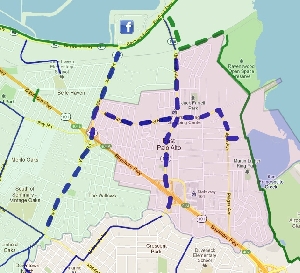Facebook has impressive goals for more than half of employees to get to work without driving alone. Over the next six years, Facebook expects to expand to 9,400 employees at the Menlo Park Campus, including new buildings across the street. But Facebook plans to provide parking spaces for less than half of its employees.
Unfortunately, the new campus in Menlo Park is less accessible by biking, walking and transit than its former locations in Palo Alto. In order to help Facebook achieve its goals, and to reduce the impact of car traffic in Menlo Park and the surrounding region, the new campus needs to be more accessible for people who aren’t driving.
Bike routes to Facebook
There are 4 key routes that could be made safer to increase the share of bike commuting to Facebook: Willow Road, University Avenue, Bay Road and the Bay Trail.
Willow Road is the swiftest route from downtown Menlo Park. Willow has bike lanes, but these lanes are not continuous. There are gaps at intersections, bus stations, substandard sections, and tire-catching grates.
However, only a small percentage of Facebook employees live in Menlo Park. According to data published in the Environmental Impact Report, over 40% of Facebook's employees live in Palo Alto, Mountain View, Sunnyvale and other South Bay communities.
Therefore, University Avenue in Palo Alto and East Palo Alto is another key bike commute route. University has faded striping and gaps that could be filled to make the route safer.
The riskiest part of Willow and University is the 101 crossing. Fortunately, in recent years Caltrans has become much more open to supporting biking and walking to get across highways. If the city makes a proposal that meets its guidelines, then bike lanes can be added on the overpass.
The Bay Trail
The greatest potential for bike commuting for South Bay residents is the Bay Trail. Away from automobiles and traffic lights, the Bay Trail provides a pleasant and speedy commute experience.
There is a one-mile gap in the Bay Trail in Menlo Park and East Palo. Cylists need get off the trail an ride on heavily-trafficked local streets in East Palo Alto. If the gap were filled, more people would bike to work. Completing the gap would connect 100 continuous miles of trail to Silicon Valley and the East Bay.
The Bay Trail is supported by a wide range of business groups and environmental groups including Sierra Club, Save the Bay, Committee for Green Foothills, Silicon Valley Bicycle Coalition, Silicon Valley Leadership Group, and Google.
Pedestrian safety issues
The traffic impact mitigations specified in the EIR include seven new turn lanes, five of which widen the street, and all of which reduce car/pedestrian visibility. This degrades the quality and safety of existing pedestrian crossings at impacted intersections. For example, the EIR proposes adding an additional right turn lane on Willow Road to Eastbound Bayfront Expressway. This would increase the number of right turn lanes from 2 to 3, which makes an already challenging intersection even more difficult to cross.
Additionally, the EIR doesn’t address gaps in the pedestrain transportation network around the Facebook campus. For example, there is no continuous pedestrian pathway from the crosswalk at Bayfront Expressway and Hacker Way to the Facebook Campus. While there is a sidewalk segment along Hacker way, it is narrow and ends before the edge of the campus buildings. The EIR should also consider pedestrian improvements such as high visibility crosswalk treatments, expanded pedestrian refuges, and reduction of corner curb radii.
Environmental impact mitigation
The Environmental Impact Report for the Facebook Campus project is currently being reviewed by the community and city. As part of the environmental process, Facebook is responsible to mitigate the impacts of traffic caused by its development.
Other cities including Palo Alto consider bicycle, pedestrian, and transit improvements as preferred choices to mitigate car traffic. Menlo Park has benefited from this approach when Palo Alto required Stanford Medical Center to invest in the Middle Road bike/pedestrian undercrossing that will help commuters to get to Stanford without driving.
Including the Bay Trail and bike lane improvements as traffic mitigations will help Facebook achieve their goals of reducing car commuting, and will help the city avoid traffic. Everyone will benefit from safe routes to Facebook.

